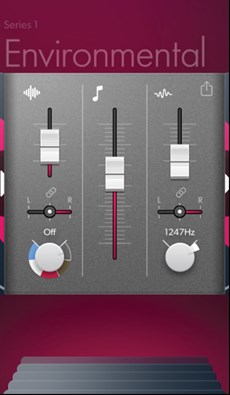If you’ve experienced an uptick in the number of your patients complaining of tinnitus lately, you are not alone. In fact, there is some evidence that the social and emotional strain of the ongoing pandemic many exacerbate tinnitus for existing sufferers; moreover, contracting COVID-19 may worsen tinnitus symptoms [1]. For patients who may not be able to afford (or may not have access to) professional tinnitus services, apps are a great way to introduce patients to self-guided tinnitus coping strategies. We have reviewed tinnitus apps previously [2] but the time is ripe to introduce some newer noteworthy options.
T-Minus
Sound therapy is a popular avenue for tinnitus-sufferers to explore: T-Minus (available for iOS) is a tinnitus wellness tool that is ideal for tinnitus sufferers who are looking for a large and highly customisable sound library. Through a detailed but well-thought-out interface, users can modify and blend a series of albums to create a personalised sound experience. The non-looped recordings are accompanied by sound controls to create further personalisation (i.e., pure tone generator, coloured noise playback and volume controls).

The app also includes a user journal, which can be used to keep track of tinnitus experiences over time. The journal is accompanied by daily tips and tricks for tinnitus sufferers. A FAQ section is also included within the app for some introductory tinnitus education. There are plans to expand the app to include guided meditation sessions, monthly webinars and peer support, though these features were not yet available when I tried the app.
Existing Apple Music or Premium Spotify users can link to their accounts through the app to access content. Otherwise, a direct paid subscription is available ($4.99 USD monthly).
“Through a detailed but well-thought-out interface, users can modify and blend a series of albums to create a personalised sound experience”
Quieten
The Quieten app (available for iOS and Android) is aimed at helping tinnitus suffers habituate to tinnitus through a series of videos and talks. The app contains a large library of mostly free content for better understanding tinnitus and learning about tinnitus coping strategies (i.e., meditation and relaxation techniques). For users looking to view the entire catalogue, subscription options are available for unlocking premium content (£2.99 per month).

It should be noted that the specific approach within the Quieten app is not evidence-based and it is impossible to vouch for the overall quality of the recommendations within the app. However, many of the techniques presented are familiar tinnitus coping strategies. This app would particularly appeal to tinnitus sufferers who are overwhelmed by the amount of information online, do not have access to professional tinnitus care, and would benefit from a digestible series of video and audio content related to tinnitus.
The Oto App
(This review was added August 2021 by Emma LeBlanc)*
Oto is an app that is marketed as a simple solution to the complex problem of tinnitus. The app has a two-pronged approach: Therapy and Sounds. Under the Therapy section, users can find daily therapy, bedtime tools, quick relief modules and exercises all in the form of pre-recorded audio modules. Under the Sounds section, there is a diverse library of masking sounds that a tinnitus suffered can choose from. With each sound the user can choose to hear it as normal, with a tinnitus notch or a tinnitus boost. The user can even put it in sleep mode and turn on a timer for it to automatically shut off.

With lots of information boxes, links to research and resources, a chat box and a help center, Oto strives to be an all-in-one solution for individuals who do not have access to in-person care or for those who prefer self-paced learning modules.
*This is not included in the pdf download option.
References
1. Beukes EW, Baguley DM, Jacquemin L, et al. Changes in tinnitus experiences during the Covid-19 pandemic. Frontiers in Public Health 2020;8:592878.
2. Falls C. Tinnitus? There’s an app for that. ENT & Audiology News 2016;25(4):120.




